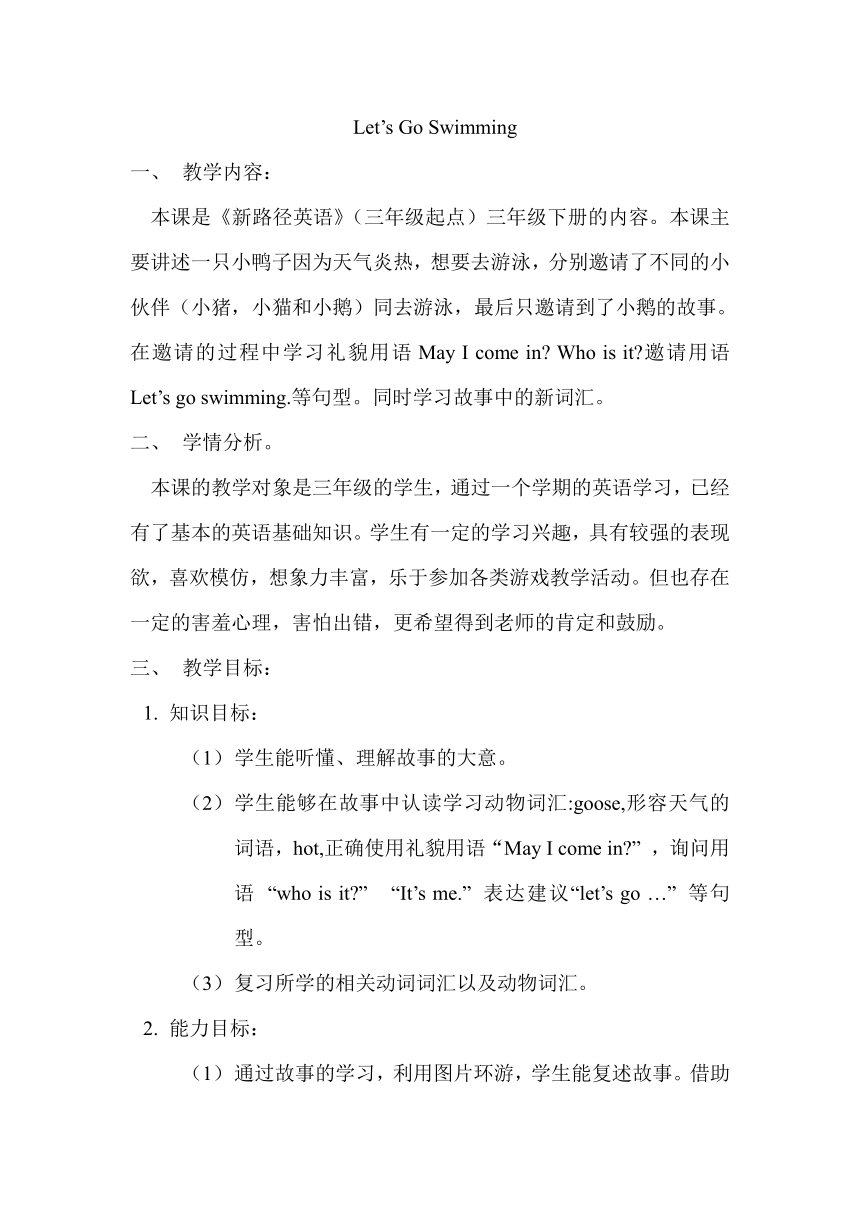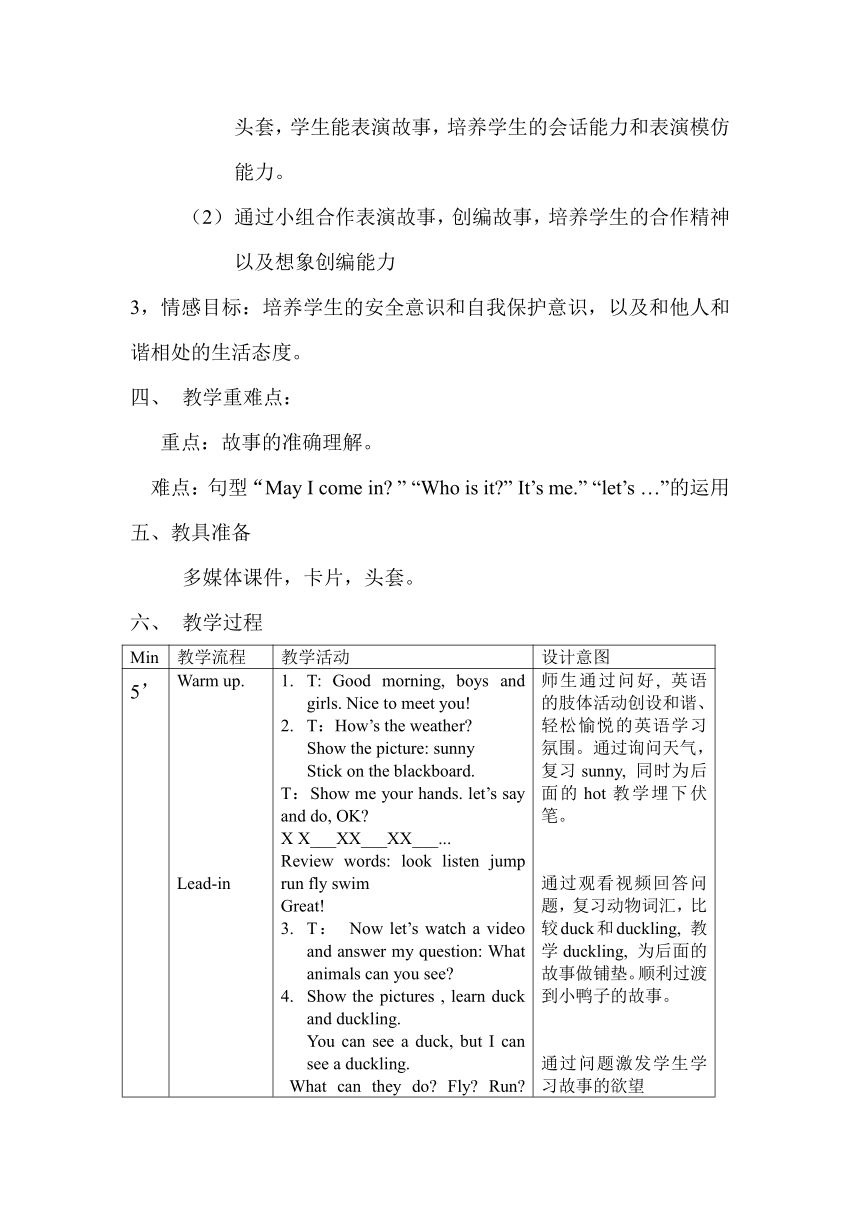Lesson N Self-assessment 教案
文档属性
| 名称 | Lesson N Self-assessment 教案 |  | |
| 格式 | doc | ||
| 文件大小 | 55.5KB | ||
| 资源类型 | 教案 | ||
| 版本资源 | 川教版 | ||
| 科目 | 英语 | ||
| 更新时间 | 2021-06-03 14:00:53 | ||
图片预览


文档简介
Let’s Go Swimming
教学内容:
本课是《新路径英语》(三年级起点)三年级下册的内容。本课主要讲述一只小鸭子因为天气炎热,想要去游泳,分别邀请了不同的小伙伴(小猪,小猫和小鹅)同去游泳,最后只邀请到了小鹅的故事。在邀请的过程中学习礼貌用语May I come in? Who is it?邀请用语 Let’s go swimming.等句型。同时学习故事中的新词汇。
学情分析。
本课的教学对象是三年级的学生,通过一个学期的英语学习,已经有了基本的英语基础知识。学生有一定的学习兴趣,具有较强的表现欲,喜欢模仿,想象力丰富,乐于参加各类游戏教学活动。但也存在一定的害羞心理,害怕出错,更希望得到老师的肯定和鼓励。
教学目标:
知识目标:
学生能听懂、理解故事的大意。
学生能够在故事中认读学习动物词汇:goose,形容天气的词语,hot,正确使用礼貌用语“May I come in?” ,询问用语 “who is it?” “It’s me.” 表达建议“let’s go …” 等句型。
复习所学的相关动词词汇以及动物词汇。
能力目标:
通过故事的学习,利用图片环游,学生能复述故事。借助头套,学生能表演故事,培养学生的会话能力和表演模仿能力。
通过小组合作表演故事,创编故事,培养学生的合作精神以及想象创编能力
3,情感目标:培养学生的安全意识和自我保护意识,以及和他人和谐相处的生活态度。
教学重难点:
重点:故事的准确理解。
难点:句型“May I come in? ” “Who is it?” It’s me.” “let’s …”的运用
五、教具准备
多媒体课件,卡片,头套。
教学过程
Min 教学流程 教学活动 设计意图
5’ Warm up.
Lead-in T: Good morning, boys and girls. Nice to meet you!
T:How’s the weather?
Show the picture: sunny
Stick on the blackboard.
T:Show me your hands. let’s say and do, OK?
X X___XX___XX___...
Review words: look listen jump run fly swim
Great!
T: Now let’s watch a video and answer my question: What animals can you see?
Show the pictures , learn duck and duckling.
You can see a duck, but I can see a duckling.
What can they do? Fly? Run? Swim?
Today , we will learn a story: let抯 go swimming
Do you know who will go swimming?
师生通过问好, 英语的肢体活动创设和谐、轻松愉悦的英语学习氛围。通过询问天气,复习sunny, 同时为后面的hot教学埋下伏笔。
通过观看视频回答问题,复习动物词汇,比较duck和duckling, 教学duckling, 为后面的故事做铺垫。顺利过渡到小鸭子的故事。
20 ’ Presentation the story 1, (1) Look at the picture, what can you see?
T: Who’ll try?
Circle the picture:sun , duckling.
How’s the weather?
Sunny like this, and now it’s hot.
Stick the big sun picture and do some actions.
(2)Listen and answer the question.
What does the duckling want to do? And why?
Listen again, check the answer. Follow it.
Why?
Listen again and follow it.
(3) If (如果)you want to go swimming, what would you do ? (go swimming alone or with your friends?)
2. The duckling comes to the house. Show the house. So house means: 房子
(1)Look at the picture, whose house is it?( pig’s house)
If you were the duckling, what would you do at first?
老师通过动作和房子模型演示这个过程
Listen and check the answer.
Follow it .
May I come in?
If you were the Little Pig , what would you do? (如果你是小猪,你会怎么做?)
T: Come in, please?
Listen and check the answer.
Does the Little Pig open the door right now? Why?
(3)How to answer? “It’s me , Duckling.”
(4) Listen and repeat.
Role-play read it.
3. Now ,Little Pig open the door .
What does Little Pig say?
Listen !
利用手势动作教学come in , please.
(4)How does the Duckling invite(邀请) the Little Pig?
Let’s listen.
Who can read it?
Little Pig, let’s go swimming.
Does the little pig go with the duckling?
Listen and check.
(5) Listen to the dialogue and follow it.
4.(1)Little pig can’t swim.
The duckling go away. He comes to the house.
Whose house is it?
老师重复呈现情景并配上动作,引导学生在适当的情境中运用出前面学习的句子:
May I come in?
Who is it?
It’s me ,Duckling.
老师来扮演little cat。分别让学生扮演little duckling.
经过老师的引导呈现出句型。
(2)Guess:Does the cat go with the little Duckling? why?
Let’s listening and find the answers.
How does the Little Cat answer the Duckling?
So , if you were the Duckling , would you go on to invite(邀请) the friend? Why or why not.
(1) The Little Duckling come to his friend’s house, whose house is it?
Is it a duck? No.
Look at the picture (duckling and goose), try to find the difference
It’s a goose. Show the picture of goose.
Try to spell it. oo→moon感受oo的发音。尝试拼读goose.
呈现图片,让学生在此情景下为图片配音。What are they talking?
Listen to the recording and check the answer.
look at the picture, at last, does the goose go with the Little Duckling?
How does the goose answer the Duckling?
Listen to the recording, and check the answer.
Can the goose swim?
Is the Duckling happy?
Listen again and follow it. 让学生观察图片,培养学生看的能力。
通过图片的比较教学hot,让学生通过感知观察理解hot 的含义。
通过学生观察图片,提问帮助学生进一步理解文本含义,通过听录音培养学生的听力,并且要求学生将所听到的内容复述出来,形成一个输入和输出的过程。
让学生思考自己去游泳会独自去还是会和小伙伴一起去?培养学生的思维,同时有助于故事的展开。
通过模拟实物教学house.观察图片后得出结论是小猪的房子。
教师通过情景模拟,让学生理解故事的发展,去朋友家时的基本文明礼仪。教学may I come in?
进一步询问小猪是否立即打开门?以及为什么?这个环节有利于培养学生的安全意识。
这个部分每个句子的学习都是通过录音来呈现并感知,让学生有正确的语音输入。
通过角色扮演,让学生熟悉此部分,掌握句型,为后面的教学做好铺垫。
让学生掌握邀请朋友的句型let’s…
跟读训练有利于熟悉故事。
这个部分通过教师的情境创设引导,再次巩固句型:
May I come in?
Who is it?
It’s me, Duckling.
以及邀请朋友的句型
Let’s go swimming.
让学生假设自己是小鸭子,是否还会去邀请其他小伙伴,以及为什么?培养学生的发散性思维。
故事的进一步展开,第三部分,小鸭子来到天鹅家,通过自然拼读教学鹅goose.
让学生观察图片后为此图配音,让学生运用所学的句型。
观察图片,回答问题,同时利用录音学习:Good idea.
Listen and repeat.
1, Listen to the recording and read the story .
2, 利用图片环游的方式,老师引导学生复述整个故事。
3. Can you swim alone? With your friends? Or with your parents?
听录音跟读故事,让学生对故事有一个完整的认识。
通过图片环游,让学生复述出整个故事,在此过程中不断强化重点句型。
通过问题,让孩子意识到安全的重要性。
2’ Homework. Read the story for your parents.
七,板书设计。
Let’s Go Swimming
Duckling→Pig→Cat→goose May I come in?
Who is it?
It’s me, Duckling.
Let’s go swimming.
2019. 4.17
教学内容:
本课是《新路径英语》(三年级起点)三年级下册的内容。本课主要讲述一只小鸭子因为天气炎热,想要去游泳,分别邀请了不同的小伙伴(小猪,小猫和小鹅)同去游泳,最后只邀请到了小鹅的故事。在邀请的过程中学习礼貌用语May I come in? Who is it?邀请用语 Let’s go swimming.等句型。同时学习故事中的新词汇。
学情分析。
本课的教学对象是三年级的学生,通过一个学期的英语学习,已经有了基本的英语基础知识。学生有一定的学习兴趣,具有较强的表现欲,喜欢模仿,想象力丰富,乐于参加各类游戏教学活动。但也存在一定的害羞心理,害怕出错,更希望得到老师的肯定和鼓励。
教学目标:
知识目标:
学生能听懂、理解故事的大意。
学生能够在故事中认读学习动物词汇:goose,形容天气的词语,hot,正确使用礼貌用语“May I come in?” ,询问用语 “who is it?” “It’s me.” 表达建议“let’s go …” 等句型。
复习所学的相关动词词汇以及动物词汇。
能力目标:
通过故事的学习,利用图片环游,学生能复述故事。借助头套,学生能表演故事,培养学生的会话能力和表演模仿能力。
通过小组合作表演故事,创编故事,培养学生的合作精神以及想象创编能力
3,情感目标:培养学生的安全意识和自我保护意识,以及和他人和谐相处的生活态度。
教学重难点:
重点:故事的准确理解。
难点:句型“May I come in? ” “Who is it?” It’s me.” “let’s …”的运用
五、教具准备
多媒体课件,卡片,头套。
教学过程
Min 教学流程 教学活动 设计意图
5’ Warm up.
Lead-in T: Good morning, boys and girls. Nice to meet you!
T:How’s the weather?
Show the picture: sunny
Stick on the blackboard.
T:Show me your hands. let’s say and do, OK?
X X___XX___XX___...
Review words: look listen jump run fly swim
Great!
T: Now let’s watch a video and answer my question: What animals can you see?
Show the pictures , learn duck and duckling.
You can see a duck, but I can see a duckling.
What can they do? Fly? Run? Swim?
Today , we will learn a story: let抯 go swimming
Do you know who will go swimming?
师生通过问好, 英语的肢体活动创设和谐、轻松愉悦的英语学习氛围。通过询问天气,复习sunny, 同时为后面的hot教学埋下伏笔。
通过观看视频回答问题,复习动物词汇,比较duck和duckling, 教学duckling, 为后面的故事做铺垫。顺利过渡到小鸭子的故事。
20 ’ Presentation the story 1, (1) Look at the picture, what can you see?
T: Who’ll try?
Circle the picture:sun , duckling.
How’s the weather?
Sunny like this, and now it’s hot.
Stick the big sun picture and do some actions.
(2)Listen and answer the question.
What does the duckling want to do? And why?
Listen again, check the answer. Follow it.
Why?
Listen again and follow it.
(3) If (如果)you want to go swimming, what would you do ? (go swimming alone or with your friends?)
2. The duckling comes to the house. Show the house. So house means: 房子
(1)Look at the picture, whose house is it?( pig’s house)
If you were the duckling, what would you do at first?
老师通过动作和房子模型演示这个过程
Listen and check the answer.
Follow it .
May I come in?
If you were the Little Pig , what would you do? (如果你是小猪,你会怎么做?)
T: Come in, please?
Listen and check the answer.
Does the Little Pig open the door right now? Why?
(3)How to answer? “It’s me , Duckling.”
(4) Listen and repeat.
Role-play read it.
3. Now ,Little Pig open the door .
What does Little Pig say?
Listen !
利用手势动作教学come in , please.
(4)How does the Duckling invite(邀请) the Little Pig?
Let’s listen.
Who can read it?
Little Pig, let’s go swimming.
Does the little pig go with the duckling?
Listen and check.
(5) Listen to the dialogue and follow it.
4.(1)Little pig can’t swim.
The duckling go away. He comes to the house.
Whose house is it?
老师重复呈现情景并配上动作,引导学生在适当的情境中运用出前面学习的句子:
May I come in?
Who is it?
It’s me ,Duckling.
老师来扮演little cat。分别让学生扮演little duckling.
经过老师的引导呈现出句型。
(2)Guess:Does the cat go with the little Duckling? why?
Let’s listening and find the answers.
How does the Little Cat answer the Duckling?
So , if you were the Duckling , would you go on to invite(邀请) the friend? Why or why not.
(1) The Little Duckling come to his friend’s house, whose house is it?
Is it a duck? No.
Look at the picture (duckling and goose), try to find the difference
It’s a goose. Show the picture of goose.
Try to spell it. oo→moon感受oo的发音。尝试拼读goose.
呈现图片,让学生在此情景下为图片配音。What are they talking?
Listen to the recording and check the answer.
look at the picture, at last, does the goose go with the Little Duckling?
How does the goose answer the Duckling?
Listen to the recording, and check the answer.
Can the goose swim?
Is the Duckling happy?
Listen again and follow it. 让学生观察图片,培养学生看的能力。
通过图片的比较教学hot,让学生通过感知观察理解hot 的含义。
通过学生观察图片,提问帮助学生进一步理解文本含义,通过听录音培养学生的听力,并且要求学生将所听到的内容复述出来,形成一个输入和输出的过程。
让学生思考自己去游泳会独自去还是会和小伙伴一起去?培养学生的思维,同时有助于故事的展开。
通过模拟实物教学house.观察图片后得出结论是小猪的房子。
教师通过情景模拟,让学生理解故事的发展,去朋友家时的基本文明礼仪。教学may I come in?
进一步询问小猪是否立即打开门?以及为什么?这个环节有利于培养学生的安全意识。
这个部分每个句子的学习都是通过录音来呈现并感知,让学生有正确的语音输入。
通过角色扮演,让学生熟悉此部分,掌握句型,为后面的教学做好铺垫。
让学生掌握邀请朋友的句型let’s…
跟读训练有利于熟悉故事。
这个部分通过教师的情境创设引导,再次巩固句型:
May I come in?
Who is it?
It’s me, Duckling.
以及邀请朋友的句型
Let’s go swimming.
让学生假设自己是小鸭子,是否还会去邀请其他小伙伴,以及为什么?培养学生的发散性思维。
故事的进一步展开,第三部分,小鸭子来到天鹅家,通过自然拼读教学鹅goose.
让学生观察图片后为此图配音,让学生运用所学的句型。
观察图片,回答问题,同时利用录音学习:Good idea.
Listen and repeat.
1, Listen to the recording and read the story .
2, 利用图片环游的方式,老师引导学生复述整个故事。
3. Can you swim alone? With your friends? Or with your parents?
听录音跟读故事,让学生对故事有一个完整的认识。
通过图片环游,让学生复述出整个故事,在此过程中不断强化重点句型。
通过问题,让孩子意识到安全的重要性。
2’ Homework. Read the story for your parents.
七,板书设计。
Let’s Go Swimming
Duckling→Pig→Cat→goose May I come in?
Who is it?
It’s me, Duckling.
Let’s go swimming.
2019. 4.17
同课章节目录
- Lesson A How are you?
- Lesson B This is my son
- Lesson C I'm from the USA
- Lesson D Let's play a game
- Lesson E What's this?
- Lesson F What's that?
- Lesson G Self-assessment
- Lesson H What day is today?
- Lesson I How's the weather?
- Lesson J Fly a kite
- Lesson K Do like this
- Lesson L What a beautiful kite!
- Lesson M Animals on the farm
- Lesson N Self-assessment
- Lesson O Can you fly?
- Lesson P What can you do?
- Lesson Q Oh, yucky!
- Lesson R How yummy!
- Lesson S Good manners
- Lesson T Self-assessment
- Lesson U A chicken or seven chickens?
- Lesson V How many rabbits?
- Lesson W So many ants!
- Lesson X It's raining hard
- Lesson Y ABC song
- Lesson Z Self-assessment
